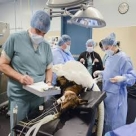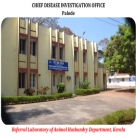Online Articles
Ensuring Quality in Veterinary Testing and Accreditation of Laboratories.,
19 - Sep - 2016
Dr. Robin Paul, M V Sc. (Food Hygiene & Public Health)

Ensuring Quality in Veterinary Testing and Accreditation of Laboratories.
Dr. Robin Paul, M V Sc. (Food Hygiene & Public Health)
Veterinary Surgeon-HG & Adjunct Faculty, KVASU.
Quality Manager, State Lab for Livestock Products, Ernakulam.
Introduction
Veterinary Laboratories in our country has long remained fragile due to fundamental limitations and lack of prioritization of human, financial and training resources; minimalist laboratory infrastructure; and poor managerial capacity. No reliable data is available either on the total number of veterinary testing laboratories in our country or their testing capabilities, even though India has a massive livestock population of more than 500 million, the majority of which rely on government services for animal health care. The increasing burden of priority diseases such as FMD, PPR, tuberculosis and new emerging zoonotic diseases in our country continues to challenge the weak existing systems. As livestock health programs have encountered challenges linked to the lack of reliable laboratory support even for basic disease diagnosis and management of patient care, the quality of Laboratory testing is conveniently ignored many a times leading to disastrous decisions.
The purpose of this article is to provide an introduction on quality management system using a continual improvement process, finally obtaining Accreditation to ensure valid laboratory results.
Laboratory Quality Standard
The standard against which laboratories are accredited (formally recognized for their competence) is ISO/IEC 17025:2005. It is entitled – General Requirements for the Competence of Testing and Calibration Laboratories. The standard is about one thing only – Competence of Laboratories. “Competence” means that the persons in a laboratory have specific knowledge and skills directly related to the science underlying their testing procedures. “Competence” means that the staff in a laboratory can demonstrate this specific knowledge. Only someone else who has the same level of knowledge and skills within that science can determine “competence”. Demonstrated conformance to ISO 17025 is a demonstration of competence. The demonstration of conformance will show that the laboratory has the people, with the skills and knowledge, the environment with the facilities and equipment, the quality control and the procedures that are required to produce valid test results. ISO 9001 can be considered as a generic overall standard for quality management systems and ISO 17025 provides specific guidance on the application of the ISO 9001 principles to laboratories.
OIE describes valid laboratory results as essential for diagnosis, surveillance and trade. Such results are achieved by the use of good management practices, valid test and calibration methods, proper technique, quality control and quality assurance, all working together within a quality management system. Laboratory quality management includes technical, managerial and operational elements of testing and the interpretation of test results. A quality management system as per ISO 17025 enables the laboratory to demonstrate both competency and an ability to generate consistent technically valid results.
National Accreditation Board for Testing and Calibration Laboratories (NABL), India.
Accreditation of laboratories is generally performed by national accreditation bodies. The primary function of such bodies is to provide assessment of laboratories in their respective countries against ISO 17025. The Government of India has authorized NABL as the accreditation body for testing and calibration laboratories. It operates as an autonomous body under the aegis of in the Department of Science and Technology (DST), Ministry of Science and Technology.
NABL will always use technical assessors who are specialists and who carry out a peer review of the methods being used by the laboratory and the way in which those methods are applied. During a typical assessment of a lab by NABL, witness testing is done for demonstrating competence.
Management and Technical requirements for Laboratory Accreditation
For grant of accreditation, the applicant laboratory must fulfil the requirement of meeting all the 25 clauses of the standard by describing its management system (15 clauses) and technical capabilities (10 clauses) to be in-line with that of the standard, the same is going to be assessed by NABL.
It is extremely unlikely that any properly constituted laboratory will need to change its management structure in any fundamental way in order to comply with the requirements of ISO 17025. The management system will, however, have to be formally described and documented in the quality manual along with a quality policy issued by the highest executive and shown on an organization chart. In the case of each level of management or individual post, there must be job descriptions to describe the responsibilities to be discharged and the authority given, plus the supervisory responsibilities of each grade.
Management Requirements include formally documenting the policies and lab systems in a quality manual, writing Standard Operating Protocols for testing, having a planned purchase protocols for goods and services, handling of complaints and improvement objectives, periodic planed audits of labs and biannual policy review of all lab activities by the top executives known as Management Review Meeting.
Technical requirements include staff qualification and training, correct layout and civil requirements, proper calibration and maintenance of all lab equipments, validation of methods and calculation of uncertainty, sampling, sample handling, quality control activities including regular participation in International proficiency assessment programs, and finally proper reporting and dispatch of lab Test Results
Conclusion
The preparation of the necessary documentation and the adaptation of the laboratory operational procedures leading to the establishment of quality systems and official accreditation is currently very difficult if not impossible for any given veterinary testing laboratories due to the vast and usually confusing standard, prerequisites and interpretations to the existing international standards. When the labs are assessed, the accreditation body i.e. NABL will, of course, determine whether labs are compliant on the day of assessment. However, the assessors will be far more interested in satisfying themselves that the labs have a robust management system which will maintain compliance on a routine basis.
It needs to be emphasized that there are no standard ways of achieving compliance; rather there are hundreds of approaches to complying with any particular requirement of ISO 17025. The lab needs to focus on the requirement itself and to find the most convenient, least time consuming and cost-effective way of obtaining accreditation. Though this article has not detailed all the clauses of the accreditation standard and its requirements, the emphasis has been only to introduce certain key systemic requirements which can ensure that a Veterinary Lab generates technically valid test results, as the wise adage goes ‘Quality is a journey and not a destination’.
References.
- IS ISO/IEC 17025: 2005; General requirements for the competence of testing and calibration laboratories.
- Complying with ISO 17025, A practical guidebook, UNIDO 2009.
- NABL 100, General Information Brochure. 2015.
- NABL102, Specific Criteria for Biological Testing Laboratories, 2012.
Download PDF Version
Others

|
EM SOLUTION IN ANIMAL HUSBANDRY |

|
Dr. Robin Paul, M V Sc. (Food Hygiene & Public Health) |

|
A PROTOCOL FOR GENERAL ANAESTHESIA IN GOATS |

|
Surgical Preparation and Asepsis |

|
Judicious use of Antibiotics |

|
Clinical Emergencies |

|
All about Chief Disease Investigation Office-CDIO Palode |

|
A book "Mindapraniyum njyanum" written by Dr.Mohanachandran released |
|
|
BOOK RELEASE |

|
CIRCULAR ON KYASANUR FOREST DISEASE |